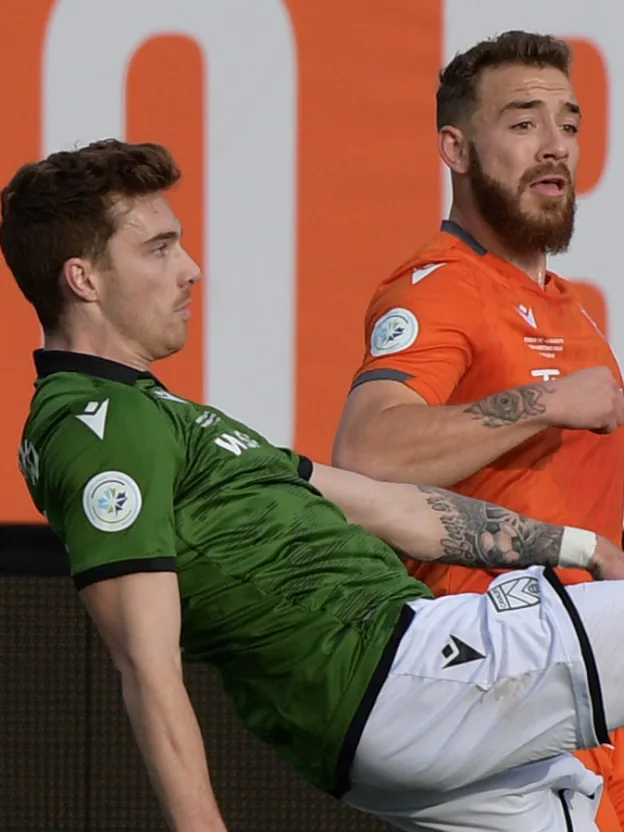To paraphrase a famous passage from Hamlet – to press or not to press, that is the question. And this was the linchpin for Cavalry FC’s set-up going into Leg 1 of the Canadian Premier League Finals last week vs. Forge FC in Hamilton. Should Cavalry sit in a compact mid-to-deep block, absorbing pressure and enticing Forge forward, in turn opening up space behind the host’s defence to counter from deep? Or should they rely on high physical pressing, forcing errors and ramping up pressure on transitions and set-pieces? In retrospect, Tommy Wheeldon Jr. got it wrong by largely choosing door number one, as Cavalry rarely looked at ease through to full time. Still, Forge helped their rivals out of jail by not smashing in more goals during a match in which they were absolutely supreme. Wheeldon may have been bullish about his team’s take-no-prisoners DNA in the lead-up to Finals 2019, but his post-match comment last week – “we were comfortable with their centre-backs having [the ball] because they weren’t hurting us” – revealed a decision to depart from type that had veered dangerously near catastrophe. Meanwhile, Forge set out with a game-plan to showcase their identity as an expansive possession-based side. Bobby Smyrniotis relied on the versatility of his players to fill gaps at fullback and the core of defence, while also getting the most of positional understanding and fluidity from players in advanced positions to overload all-important central areas.
RELATED READING: ‘Dare to be different’: Wheeldon Jr. heeds his father’s advice
Wheeldon’s decision to relinquish time and space on the ball to Forge played into his strategy and was found out. So, beyond the stats and highlight clips, how did Forge manage it? Cavalry’s 4-4-1-1 defensive shape early in the match created a situation for the front tandem – Dominique Malonga and Oliver Minatel – to both press the Forge centre-backs and remove space from Forge’s deep-lying midfield pivot in their 4-2-1-3 attacking shape. The idea seemed to work initially, with Forge’s centre-backs pinging long balls to bypass a medium block rather than play through it. Cavalry even had some good forays forward in the first 20 minutes, creating a handful of set-piece opportunities. But Forge were physically resilient in these moments, and wise to the plot. To begin with, Kyle Bekker and Alexander Achinioti-Jonsson were positioned in a double-pivot pairing in front of the back four and proved integral to the tactical success of Forge with their intelligent movement. Compact and strong defensively, it was rather their economical use of the ball and positioning in possession that created angles to break down the front line of Cavalry’s block. It also laid the groundwork for a domino effect of overloads further up the pitch. With only two Cavalry players pressing the Forge centre-backs and midfield pivots, Cavalry were outnumbered 5v2 (with support behind the ball from goalkeeper, Triston Henry) in the first phase of Forge’s build-up. Then Forge made a slight tactical tweak, Jonsson dropping in between Forge centre-backs’ Daniel Krutzen and David Edgar in possession, effectively building up with three players plus Henry. Now the three outfield players could fan out in width, while Henry would support from behind. The distance and support made it impossible for Cavalry’s front two to effectively close the player on the ball; Forge defenders had plenty of time to get their heads up and pick out forward passes.
RELATED READING: ‘As eager as possible’: Forge welcome Leg 2 reinforcements in Samuel, Owundi
Wheeldon later said he was fine with this situation, but it quickly caused problems further down the chain. The numerical supremacy and comfort in possession allowed Forge to move fullbacks Giuliano Frano and Kwame Awuah high up the pitch, essentially pulling their markers – Cavalry’s Nico Pasquotti and Jose Escalante – into unfamiliar zones as auxiliary fullbacks. With their wide players dropping off, Cavalry’s central midfield pairing of Nik Ledgerwood and Julian Buscher were left isolated and with a dilemma. Should they press Bekker, now in a single deep-lying pivot role? Or try and intercept passes into the trio of Tristan Borges, Chris Nanco and Elimane Cisse, all of whom could pop off the front and drift into the growing gaps in midfield? As good as Cavalry’s midfield pair are, they couldn’t do both jobs at once; Forge developed 4v2 overloads against both Cavalry’s front two and their central midfield duo. Too much territory had been ceded, and possession of the ball and penetration through the first two-thirds of the pitch was assured for Forge. Forge’s shape morphed in the attacking phase to something closer to a 3-1-3-3, while Cavalry’s began to look more like a back six with their wide players pinned and the pair of central midfielders and forwards ahead increasingly lost in a sea of opponents. Before long Forge were running riot in all areas of the park with their rat-a-tat passing. Dividends would soon pay off. An initial golden attacking sequence arrived via Awuah and Frano linking up from opposite flanks in the 35th minute, their advanced positions allowing them to attack the box and overload central areas.
Just minutes later, the penalty and dismissal to Joel Waterman was created as Forge was able to repress from these advanced positions, with Awuah, Bekker and Cisse pressuring the ball and punishing Cavalry when they tried to escape the overload. Pasquotti, in unfamiliar territory, eventually ran directly into the elaborate mousetrap.
Even Krutzen’s free kick that smashed off the bar was a product of Forge’s ability to press high due to their advanced collective position, arriving as it did from Frano and Bekker forcing a desperate foul from Buscher.
The circumstances for the key breakthrough period of the first half – Borges’ goal in extra time – was paved by the freedom and interplay Nanco and Awuah were enjoying down Cavalry’s right flank. Drifting inside and outside as they pleased, neither Dominick Zator nor Pasquotti were able to figure out which attacker to pick up. Finally, in the video clip below, note the late run overload created by Frano in the centre of the box on Borges’ goal: even though he didn’t end up getting involved in the finish, it’s a great example of the numerical dominance Forge were creating in the most important attacking zone.
Still, the fact remains that for all the tactical excellence, flexibility and quality on the ball in the first leg, Forge are still only one goal up going into a difficult second leg. You can be sure Forge will walk into a very different reality at Spruce Meadows in Leg 2 on Saturday than they were able to manufacture in the first match at Tim Horton’s Field. Along with the variable of natural elements, the script in Finals 2019 may very well be flipped entirely in the second leg if Cavalry revert at home to what they usually do very well: pressing high, forcing a succession of attacking set-pieces, and simply giving no time for Forge’s operators to possess the ball, advance their fullbacks, and pick out forward passes.

